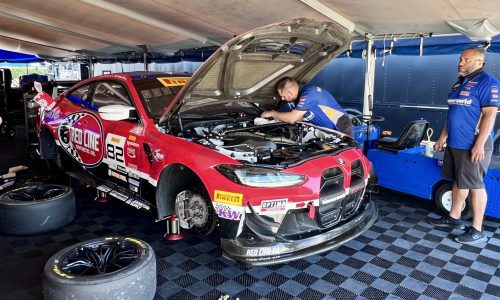By: Katrina Salokar | East Lee County News
On May 16, 2025, I visited Sebring International Raceway on the first day of an exciting weekend-long series hosted by SRO Motorsports Group, one of the premier organizers in global sports car racing. This prep day offered a unique opportunity to speak with instructors, drivers, and crew members before the intensity of race day fully took hold.
From the classrooms of the Skip Barber Racing School to the pit crews of BMW’s BimmerWorld team, I connected with individuals shaping the future of American racing. Their stories highlighted a culture driven by passion, innovation, and resilience.
Q&A with Skip Barber Racing School’s Carter Fartuch
While attending the SRO Motorsports event, I spoke with Carter Fartuch, Chief Instructor and Director of Instructors for the renowned Skip Barber Racing School. He shared insights about the school’s legacy, operations, and motorsports’ evolving landscape.
Q: Where is the Skip Barber Racing School based today?
A: Originally founded in Connecticut, we now operate out of Long Island, New York, with our main shop at Virginia International Raceway (VIR)—a 50,000-square-foot facility where we build and maintain our cars. We travel nationwide, hosting racing schools from California to Sebring.
Q: How many racing schools do you host annually?
A: Around 30 to 40 this year alone.
Q: Are these schools tied to events like today’s race at Sebring?
A: Some are, especially during professional race weekends. But most are private track rentals on weekdays for uninterrupted learning.
Q: Who do you train? Is it just aspiring professionals?
A: Everyone—from complete beginners to seasoned pros. We offer a one-day school for newcomers, a three-day school as our core program, and a two-day advanced school. We also run the Skip Barber Race Series, a launchpad to IndyCar or Formula 1. About 50 current NASCAR drivers are our alumni.
Q: Would you say you’re the premier racing school in the U.S.?
A: Absolutely. I’m a graduate myself. Around 80% of today’s IndyCar field came through our program.
Q: Who was Skip Barber, and what’s his legacy?
A: Skip is still alive. He raced in Formula One and introduced techniques like trail braking. In 1975, he founded the school to teach these methods.
Q: Is urban development threatening the future of racetracks?
A: Definitely. Tracks are often shut down due to noise complaints, even when they existed before nearby development. Some tracks survive by staying far from urban centers, but that’s changing.
Q: Are there any places doing it right?
A: Circuit of the Americas in Austin is a model—close to the city and airport, economically impactful, and community-supported. They’re even building an amusement park.
Q: How’s the economy affecting motorsports?
A: Rising costs make it tough for new drivers, but fan interest is growing, helped by Netflix’s Formula 1 series. Many attendees say that documentary brought them here.
Q: What’s happening at Sebring today?
A: We’re part of the SRO Motorsports event. Today is mainly prep, but our Touring Car America group has two races today and one tomorrow. These are modified street cars, making the sport feel relatable.
Q: Are the drivers in your cars students?
A: Most started with our three-day school. Drivers like the Garcia brothers and James Climus came through our full program.
Q: I also met a young man from England with the Aston Martin team. Can you tell me about that?
A: Aston Martin sends factory engineers to support their race cars. The person you met handles data analysis and tuning—he flew in from Coventry to assist.
Skip Barber Racing School remains a launchpad for top-tier talent. Whether you’re a newcomer or a rising pro, it’s an institution shaping the future of motorsports.
From the Classroom to the Track: Meet the Garcia Brothers
Alex and Michael Garcia are two such drivers—homegrown talent racing at Sebring under the Skip Barber Racing School banner.
Q: Can you introduce yourselves?
A: Alex: I’m Alex Garcia, 24 years old.
Michael: And I’m Michael Garcia, 29.
Q: What are you racing today, and how’s it going so far?
A: Alex: We’re sharing the number 7 car for Full Pace Racing with Skip Barber. Sebring is our home track, and we’re feeling confident.
Michael: The car’s getting better each run. Sonoma was great. COTA was challenging, but we’re making progress.
Q: So you both live close to the track?
A: Michael: We’re based in Orlando, just a couple of hours away.
Alex: We’ve been coming to Sebring for years—it feels like home.
Q: What series are you racing in today?
A: Michael: Pirelli GT4 America.
Alex: It’s an hour-long race—we split it evenly. I start, drive 30 minutes, then switch with Michael.
Their story is a living testament to the Skip Barber Racing School’s pipeline—from classroom to podium.
Breaking Barriers: James Climus on Racing with One Arm
James Climus is pushing the limits of what’s possible in racing, competing with only one arm in Touring Car America.
Q: What’s your name and where are you from?
A: My name is James Climus. I’m from Middletown, Connecticut.
Q: What brings you to Sebring this weekend?
A: I’m racing in Touring Car America with my Toyota GR Corolla. It’s my first year driving this car in competition.
Q: Can you share your journey into racing?
A: I raced in the GR Cup last year with a modified car due to my disability. Toyota outfitted it with paddle shifters for my right arm. That gave me my first shot at real competition.
Q: Did you train with Skip Barber Racing School?
A: Yes, I completed both the three-day and advanced two-day programs using my own modified GR86.
Q: What series are you competing in today?
A: TC America—Touring Car America. Toyota, Hyundai, and Acura all compete. Toyota is new to the series, so we’re still dialing in performance.
Q: What’s unique about your car?
A: It’s a Toyota GR Corolla, nearly stock. Same engine, drivetrain, and transmission as the dealership version—just upgraded for track safety and performance.
Q: What message do you hope your story sends to others?
A: That if you’re passionate and adaptable, you can compete—no matter the challenges.
Fueling Performance: A Conversation with BimmerWorld’s David Wollman
I also caught up with David Wollman, head of fueling operations for the BimmerWorld team, competing in the Pirelli GT4 America series.
Q: Can you introduce yourself and your role?
A: I’m David Wollman, head of fueling operations for BimmerWorld.
Q: What is BimmerWorld?
A: A company founded by James Clay specializing in aftermarket performance parts and racing modifications for BMWs.
Q: What event are you racing in this weekend?
A: We’re racing two BMW M4 GT4s in the Pirelli GT4 Challenge, part of the SRO Motorsports America series.
Q: How would you compare GT3 and GT4?
A: GT3 has more horsepower and sophistication. GT4 is a step below but still highly competitive.
Q: How is your team structured?
A: We own the vehicles. Each car has two drivers, either amateur-amateur or pro-amateur combinations.
Q: How long have you been in racing?
A: I’ve been with BimmerWorld for 13 years. I started driving in 1996 and still compete.
Q: What’s the economic impact of tracks like Sebring?
A: Huge. Teams, fans, and support staff spend money locally. Tracks are economic drivers—just like airports. But as development creeps in, noise complaints increase.
Q: Is fan interest growing?
A: Definitely. NASCAR leads in the South, but sports car racing is rising. More people are learning performance driving, and even consumer cars are becoming more track-capable.
Q: Are there any industry associations for motorsports?
A: Not one overarching body. Each series like NASCAR or IndyCar has its own structure. For amateurs, SCCA is a major organization.
My visit to Sebring was more than an exploration of speed—it revealed the heart of a powerful industry. Florida’s motorsports heritage is not only cultural, but also economic. From Daytona to Sebring, racing fuels tourism, job creation, and small business growth.
With a year-round climate and a passionate fanbase, Florida is poised to grow its leadership in motorsports. Whether through elite driver training, innovative racing platforms, or inclusive stories like James Climus’, the Sunshine State is paving the road ahead.








